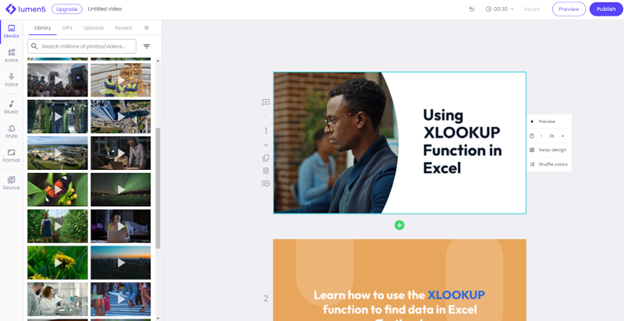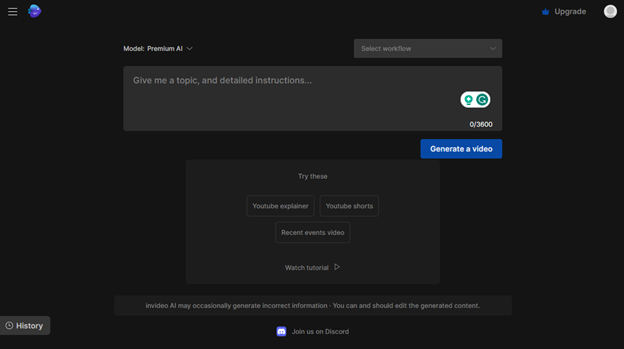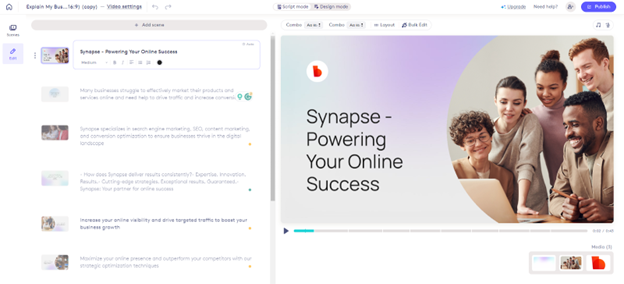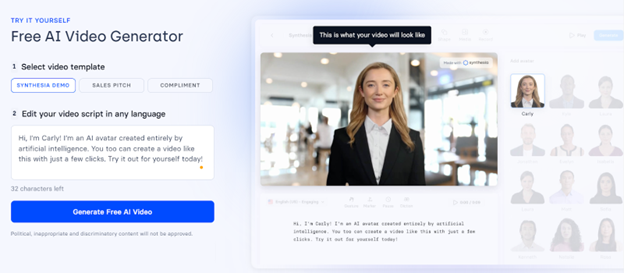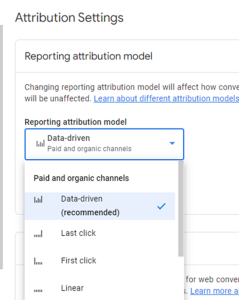4 Best AI Video Generators for Marketing in 2024
 As businesses increasingly invest in video content, the numbers speak for themselves. According to HubSpot’s State of Marketing Report, 87% of video marketers confirm that incorporating video content has led to an increase in traffic to their websites. Additionally, 80% of video marketers say that incorporating video content has directly contributed to increased sales.
As businesses increasingly invest in video content, the numbers speak for themselves. According to HubSpot’s State of Marketing Report, 87% of video marketers confirm that incorporating video content has led to an increase in traffic to their websites. Additionally, 80% of video marketers say that incorporating video content has directly contributed to increased sales.
In light of these compelling statistics and the evolving landscape of content creation, AI video generators have emerged as transformative tools. An AI video generator can effectively simplify the video creation process by leveraging advanced algorithms to automate tasks from script analysis to visual editing. This transformative tool not only streamlines content creation but also enhances the overall quality of videos, enabling businesses to respond to the increasing demand for engaging visual content in today’s digital marketing landscape. In this guide, we will discuss some of the best AI video tools on the market today, their key features, pricing, and other functionalities you should be looking for if you’re interested in using AI to improve your video workflow.
Why Adopt an AI Video Tool to Streamline Video Creation?
AI enhances video creation by automating and streamlining various tasks, from script analysis to visual editing. This results in a considerable reduction in the time and effort traditionally required for video production. The benefits of integrating AI into the creative workflow are multifaceted. First and foremost is the remarkable speed at which AI can generate high-quality videos, enabling marketers to meet tight deadlines and keep up with the demands of a fast-paced digital landscape. Moreover, AI’s efficiency is evident in its capacity to handle repetitive tasks, allowing individual creators to focus on more strategic and creative aspects. Additionally, the customization capabilities of AI video generators empower marketers to tailor content to specific audiences, ensuring relevance and resonance. Overall, AI Video generators are both time and cost-efficient in producing personalized video content.
4 Best AI Video Generators
An AI video generator can be a valuable asset for your business and marketing strategy. However, with so many options out there, how can you choose the right tool for your needs? Below, we explore four standout AI video generators—Lumen5, InVideo AI, Biteable, and Synthesia. Each tool has earned its place in the spotlight for distinct reasons, ranging from user-friendly interfaces to advanced script automation, robust analytics capabilities, and cutting-edge AI avatar creation.
- Lumen5: Best for its easy-to-use interface
- InVideo AI: Best for script automation
- Biteable: Best for robust analytics
- Synthesia: Best for AI avatar creation
Lumen5
If you are just diving into the creative scene, Lumen5 is the ideal AI video generator with an easy-to-use interface that plays nicely with all skill levels. Lumen5 is particularly effective in emphasizing and visualizing text-based content, making it suitable for transforming articles and blog posts into video format using the blog link or any written content.
Pros:
- Text-to-Video: It excels at turning text content, such as your existing blog posts, into engaging videos, suitable for content repurposing.
- AI Voices: Users can easily switch between over 40 different voices while creating their videos.
Cons:
- Limited Customization: While efficient, Lumen5’s customization options might be more limited compared to other platforms.
- Considerable Delay on video playback/preview
Pricing:
- Community: $0 for up to five videos per month
- Basic: $19 per month, billed yearly, or $29 billed monthly
- Starter: $59 per month, billed yearly, or $79 billed monthly
- Professional:$149 per month, billed yearly, $199 billed monthly
- Enterprise: Custom pricing tailored to specific needs
InVideo AI
InVideo AI is renowned for its ability to generate impressive videos by automatically generating scripts based on the user’s text prompts. Simply convey your intentions in plain English, and the tool brings your vision to life. The more detailed your prompt, the better your results. Additionally, you can reference any blog post from the web to create your script.
Pros:
- AI-Powered Script Generation: Generate scripts effortlessly using AI with basic text prompts
- Effortless Clip Replacement: Seamlessly replace clips or scripts automatically generated by the AI tool with alternative options from the stock library or personal album
- Easy Edit: Instead of manually editing the script or searching for additional images, users can provide comments to edit the video.
Cons:
- Considerable lag during export and video editing.
- Limited script input: For any script or blog post, there is a 50-line cap when using InVideo’s AI-powered video generator.
Pricing:
- Free: $0 for 10 mins/week of AI generation and 4 videos per week with InVideo logo
- Plus: $20 per month, billed monthly, or $240 billed yearly
- Max: $48 per month, billed monthly, or $576 billed yearly
Biteable
Compared to other AI-powered video generators, Biteable stands out by providing a robust analytics suite that offers real-time insights into viewer engagement, locations, and overall video performance. This feature empowers creators to refine their content strategy based on data-driven insights. Additionally, Biteable allows users to collaborate on video creation within the platform, streamlining the collaborative process.
Pros:
- Collaboration: Team members can create together within the platform.
- Real-Time Analytics for Effective Video Marketing: The analytics suite includes viewer, engagement, and location insights, empowering creators to refine content based on performance and enhance overall video effectiveness.
- Extensive Template Collection: With over 5,000 project templates tailored for specific occasions or purposes, such as “thank you” messages, celebration videos, and education videos, users can choose from a diverse range of themes and options. Additionally, exclusive premium templates are accessible to Business and Unlimited plan users.
Cons:
- Challenging Editing Process: Editing the video is not as easy and intuitive as other alternatives on the market.
- Pricing Tiers: Some advanced features might be available only in higher-priced plans.
Pricing:
- Pro: $49 per month, billed monthly, or $588 billed yearly
- Premium: $99 per month, billed monthly, or $1,188 billed yearly
- Business: Custom pricing tailored to specific needs
Synthesia
Synthesia is best known for its AI avatars: users can choose between more than 140 AI avatars. Users can create their own avatars and gendered audio in more than 120 languages. This feature is particularly advantageous for companies aiming to establish a distinctive visual identity in a crowded digital space.
Pros:
- AI Avatars Selection: Natural-sounding AI avatars and extensive artificial intelligence avatar library, and collaborative elements, including over 140 AI avatars and more than 120 languages.
- Customization Options: Tailor videos with customizable backgrounds and branding colors, providing a unique visual identity.
- Collaborative Elements: Facilitate collaboration by easily sharing internal video links with other users for direct feedback on the platform’s feed.
Cons:
- Limited Emotional Expression: The avatars, lacking diverse facial expressions and the ability to convey human emotion, result in videos that may come across as robotic and clinical.
- Limited Scalability: The manual production of each video limits scalability, posing challenges for users in terms of efficiently handling larger-scale video production tasks.
Pricing:
- Starter: $22 per month, billed monthly, or $264 billed yearly
- Creator: $67 per month, billed monthly, or $804 billed yearly
- Enterprise: Custom pricing tailored to specific needs
What To Consider When Choosing an AI Video Creator
Each AI video generator presents unique strengths and considerations. Lumen5 excels in ease of use, InVideo AI stands out for its AI-powered script generation, Biteable offers versatility and real-time analytics, and Synthesia brings innovation with its extensive AI avatar library. Understanding the distinctive strengths and considerations of each AI video generator is crucial in selecting the right tool tailored to specific creative needs.
With capabilities that range from automating intricate editing tasks to providing efficient customization options, AI video generator becomes an asset in crafting valuable and impactful videos. This empowers businesses to generate high-quality videos swiftly and with enhanced customization options, saving both time and resources while ensuring a consistent and professional aesthetic across all video content. Therefore, we strongly encourage businesses to explore and experiment with various AI video generators to optimize their efficiency in video content creation. When choosing a platform, make sure to prioritize your specific objectives and needs. Consider factors such as the desired level of customization, collaboration features, and budget constraints before making a selection.
If you have any questions regarding AI-generated content or have more general content development and optimization needs, please contact us by email at sales@synapsesem.com.
What You Need to Know About the Data-Driven Attribution Model In GA4
First click, linear, time decay, and position-based attribution models are going away across Google Ads and Google Analytics
- Starting in May 2023, Google will remove the ability to select first click, linear, time decay, and position-based attribution models for conversion actions in Google Ads that do not already use one of these models.
- Starting in September 2023, these four rule-based attribution models will be removed from Google Ads and Google Analytics.
What happens to conversion actions if these attribution models are removed?
Once these four attribution models are removed in September 2023, they will also be removed from the reporting throughout the rest of Google Analytics, including the Overview page and the Model comparison report within the Attribution tab.
Any conversion actions still using these models will be switching automatically to data-driven attribution, the default attribution model moving forward. If you want to continue using the last-click attribution model, you have the option to manually switch to the last-click model. To do that, you would need to access the Attribution section in GA4, which can be found in the Admin tab.
What is the Data-Driven Attribution model?
Data-driven attribution takes into account the actual data collected on customer interactions and behaviors to determine the impact of each touchpoint on the conversion or desired outcome. It utilizes statistical models and machine learning to analyze large sets of data and identify the relative contribution of each touchpoint.
Attribution Reportings in GA4
There are two main reports in GA4, the model comparison tool and the conversion paths report, which can be found in the attribution reports sections.
With the model comparison tool, users can analyze how conversion credit shifts under different attribution models and assess how these models impact the evaluation of different marketing channels. The tool presents data in a table format for conversions and revenue, offering a clear view of these metrics across different channels and different attribution models. For instance, one can compare data from the Last-Click Model with that of the Data-Driven Attribution Model. The model comparison report can help users understand how different models attribute conversions to various touchpoints, before altering the attribution settings in GA4.
The conversion paths report, similar to the funnel report in Universal Analytics, provides the option to switch between various attribution models. This report offers valuable insights into the channels within a multi-channel conversion path, allowing for a deeper understanding of customer journeys.
Potential Concerns Regarding the Attribution Model Update in GA4
The key advantage of data-driven attribution is its ability to provide a more accurate and granular understanding of the customer journey. By considering multiple touchpoints and their interactions, it can reveal the true influence and value of each touchpoint in driving conversions or desired outcomes.
In the meantime, we believe that removing the four attribution models and defaulting to the GA4 data-driven model may lead to an increase in reporting complexity. Rule-based attribution models provide clear and straightforward insights into the contribution of specific touchpoints. They offer a simplified view that makes it easier to understand and communicate with stakeholders. On the other hand, data-driven attribution models can be more complex and make it challenging to pinpoint the channel that is truly driving conversions. Furthermore, since these models necessitate advanced statistical analysis, they may require a substantial amount of data to deliver the most accurate results.
Other Challenges
The removal of these attribution models may pose challenges in comparing future data with past performance, as the change in the attribution model could introduce discrepancies. The discrepancy in data resulting from the change in the attribution model could hinder the ability to make “apple-to-apple” comparisons and evaluate the effectiveness of marketing efforts over time.
As new features, such as the attribution models and reports, emerged with the new GA4 platform, it is strongly recommended to set up your GA4 prior to the deadline and familiarize yourself with the platform. If you require any assistance in migrating to GA4, please feel free to reach out to us using this form.

